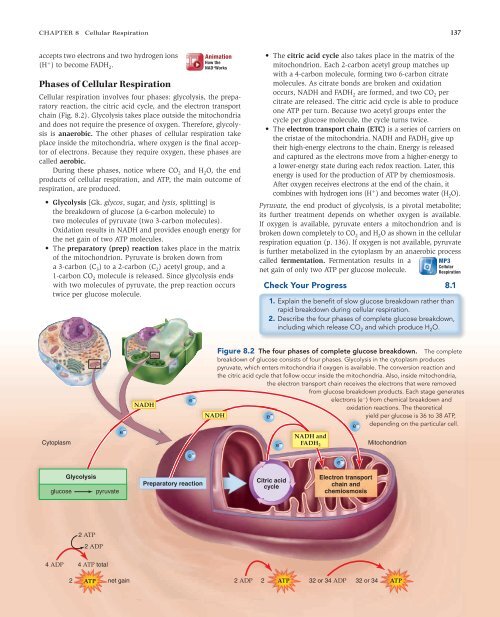Cellular Respiration
Cellular Respiration
Cellular Respiration
Create successful ePaper yourself
Turn your PDF publications into a flip-book with our unique Google optimized e-Paper software.
CHAPTER 8 <strong>Cellular</strong> <strong>Respiration</strong> 137<br />
accepts two electrons and two hydrogen ions<br />
(H + ) to become FADH 2 .<br />
Phases of <strong>Cellular</strong> <strong>Respiration</strong><br />
<strong>Cellular</strong> respiration involves four phases: glycolysis, the preparatory<br />
reaction, the citric acid cycle, and the electron transport<br />
chain (Fig. 8.2). Glycolysis takes place outside the mitochondria<br />
and does not require the presence of oxy gen. Therefore, glycolysis<br />
is anaerobic. The other phases of cellular respiration take<br />
place inside the mitochondria, where oxygen is the fi nal acceptor<br />
of electrons. Because they require oxygen, these phases are<br />
called aerobic.<br />
During these phases, notice where CO 2 and H 2O, the end<br />
products of cellular respiration, and ATP, the main outcome of<br />
respiration, are produced.<br />
• Glycolysis [Gk. glycos, sugar, and lysis, splitting] is<br />
the breakdown of glucose (a 6-carbon molecule) to<br />
two molecules of pyruvate (two 3-carbon molecules).<br />
Oxidation results in NADH and provides enough energy for<br />
the net gain of two ATP molecules.<br />
• The preparatory (prep) reaction takes place in the matrix<br />
of the mitochondrion. Pyruvate is broken down from<br />
a 3-carbon (C 3 ) to a 2-carbon (C 2 ) acetyl group, and a<br />
1-carbon CO 2 molecule is released. Since glycolysis ends<br />
with two molecules of pyruvate, the prep reaction occurs<br />
twice per glucose molecule.<br />
Cytoplasm<br />
4 ADP<br />
Glycolysis<br />
glucose pyruvate<br />
2<br />
2 ATP<br />
2 ADP<br />
4 ATP total<br />
e –<br />
NADH<br />
e –<br />
e –<br />
Preparatory reaction<br />
Animation<br />
How the<br />
NAD + Works<br />
• The citric acid cycle also takes place in the matrix of the<br />
mitochondrion. Each 2-carbon acetyl group matches up<br />
with a 4-carbon molecule, forming two 6-carbon citrate<br />
molecules. As citrate bonds are broken and oxidation<br />
occurs, NADH and FADH2 are formed, and two CO2 per<br />
citrate are released. The citric acid cycle is able to produce<br />
one ATP per turn. Because two acetyl groups enter the<br />
cycle per glucose molecule, the cycle turns twice.<br />
• The electron transport chain (ETC) is a series of carriers on<br />
the cristae of the mitochondria. NADH and FADH2 give up<br />
their high-energy electrons to the chain. Energy is released<br />
and captured as the electrons move from a higher-energy to<br />
a lower-energy state during each redox reaction. Later, this<br />
energy is used for the production of ATP by chemiosmosis.<br />
After oxygen receives electrons at the end of the chain, it<br />
combines with hydrogen ions (H + ) and becomes water (H2O). Pyruvate, the end product of glycolysis, is a pivotal metabolite;<br />
its further treatment depends on whether oxygen is available.<br />
If oxygen is available, pyruvate enters a mitochondrion and is<br />
broken down completely to CO2 and H2O as shown in the cellular<br />
respiration equation (p. 136). If oxygen is not available, pyruvate<br />
is further metabolized in the cytoplasm by an anaerobic process<br />
called fermentation. Fermentation results in a<br />
net gain of only two ATP per glucose molecule.<br />
Check Your Progress 8.1<br />
1. Explain the benefit of slow glucose breakdown rather than<br />
rapid breakdown during cellular respiration.<br />
2. Describe the four phases of complete glucose breakdown,<br />
including which release CO 2 and which produce H 2 O.<br />
NADH<br />
e –<br />
Figure 8.2 The four phases of complete glucose breakdown. The complete<br />
breakdown of glucose consists of four phases. Glycolysis in the cytoplasm produces<br />
pyruvate, which enters mitochondria if oxygen is available. The conversion reaction and<br />
the citric acid cycle that follow occur inside the mitochondria. Also, inside mitochondria,<br />
the electron transport chain receives the electrons that were removed<br />
from glucose breakdown products. Each stage generates<br />
electrons (e� ) from chemical breakdown and<br />
oxidation reactions. The theoretical<br />
yield per glucose is 36 to 38 ATP,<br />
depending on the particular cell.<br />
Citric acid<br />
cycle<br />
NADH and<br />
FADH 2<br />
Electron transport<br />
chain and<br />
chemiosmosis<br />
Mitochondrion<br />
ATP net gain<br />
2 ADP 2 ATP 32 or 34 ADP 32 or 34 ATP<br />
e –<br />
e –<br />
e –<br />
MP3<br />
<strong>Cellular</strong><br />
<strong>Respiration</strong>

















